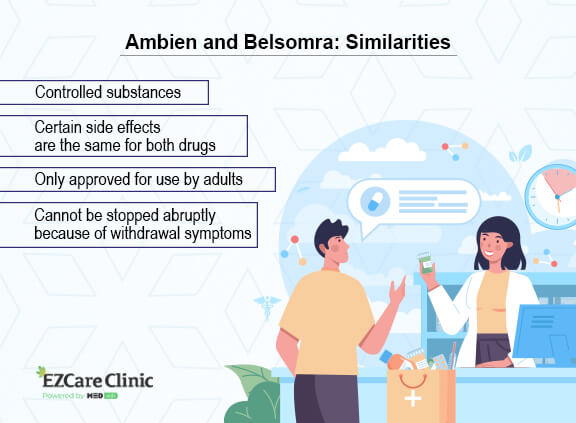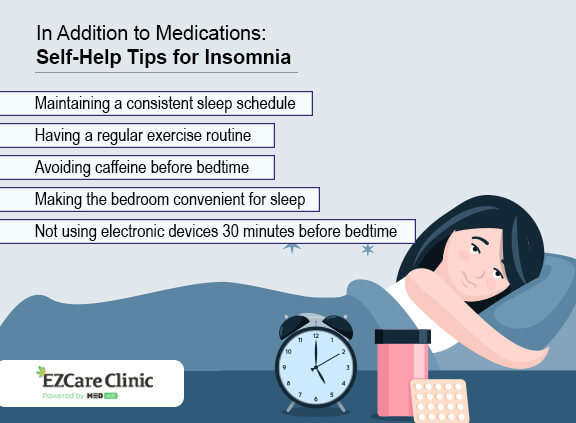Insomnia is a condition that affects one’s quality of sleep by making it difficult to either fall or stay asleep. The usual approach to treating it is using cognitive-behavioral therapy (CBT). However, when this fails, other sleeping aids like medications are required.
Some of the common drugs used for treating insomnia are Belsomra and Ambien. This article examines their specifics, similarities, and differences to help patients understand how they work and how their effects may help to overcome sleep issues.
Contact us to get a personalized treatment plan for insomnia.
What Is Belsomra?
Belsomra is the brand name of suvorexant, the active ingredient in the drug. The FDA approved it in 2014 for the treatment of insomnia, and Merck produces it. The drug falls under the Orexin receptor antagonists group of medicines.
What Is Ambien?
Ambien is a brand-name drug containing the active ingredient Zolpidem, and Sanofi-Aventis manufactures it. It is FDA-approved for the treatment of insomnia and falls under a group of medicines called sedative-hypnotics.
Ambien Vs. Belsomra: Differences
While both Ambien and Belsomra are used for the treatment of insomnia, they have significant differences. The main ones are:
- Working Mechanism
Ambien, as a sedative-hypnotic, works by activating the GABA neurotransmitters, which slow down the Central Nervous System (CNS) and the brain. As a result of the slowed-down brain activity, you fall asleep easily.
Belsomra, on the other hand, is an orexin receptor antagonist. Orexin receptors have various functions, including promoting wakefulness. By blocking the activity of orexin, the drug improves sleep.
- Generic Forms
Ambien generic forms are available in line with the standard Ambien drug. On the contrary, there is no Belsomra generic. Further, Ambien has an extended-release version, which is available in tablet form, oral spray, and sublingual pills. Belsomra is available only in tablet form.
- Dosage
The standard dosage also varies between the two drugs. Belsomra is available in 5 mg, 10 mg, 15 mg, and 20 mg tablets. Usually, patients are recommended to take 10 mg of the drug once at night by mouth 30 minutes before bedtime. After that, one should have at least 7 hours to sleep. The maximum daily dosage for Belsomra is 20mg.
On the other hand, Ambien has 5 mg and 10 mg tablets, while the extended-release version has 6.25 mg and 12.5 mg pills. The drugs should be taken just before getting to bed, and the patient should have at least 7-8 hours of sleep. Women start with 5 mg, and men start with either 5 mg or 10 mg. The maximum dosage for both is 10 mg once a day.
The patient’s physician is best placed to determine the suitable dosage considering several factors.

- Side Effects
The side effects of Ambien and Belsomra are different. For example, Belsomra’s side effects include infection in the upper respiratory tract, cough, sleepiness, and abnormal dreams. Ambien’s side effects include loss of coordination and balance, constipation, stuffy nose, lightheadedness, euphoria, nausea, and sore throat. However, certain side effects are common across the two medicines. These include diarrhea, headaches, dry mouth, daytime drowsiness, and dizziness.
- Cost
The two drugs also differ in terms of cost. Ambien is generally slightly more expensive for the brand-name drug versions compared to Belsomra. However, Ambien has generic versions, which drive the cost low, and it can even get to below $20, while the cheapest Belsomra will still cost several hundred dollars.
Ask a doctor about the dosage and side effects of Ambien to ensure the effectiveness of your treatment.
Belsomra Similar to Ambien?
Considering they both serve some purposes, there are a few similarities between the two drugs. Some of them are as follows:
- Federally Controlled Status
Both Ambien and Belsomra — are controlled substances. This status has them classified as Schedule IV drugs because they can lead to dependence and misuse.
- Approved Age
Both Ambien and Belsomra are only approved for use by adults. Those under 18 years cannot use the drugs to treat insomnia.
- Withdrawal Symptoms
If patients stop using either Ambien or Belsomra abruptly, they will likely suffer from withdrawal symptoms. It is a risk that accompanies both of these medications, and patients should follow the guidance of their doctor on when and how to stop using them.
- Drug Interactions
Both Belsomra and Ambien can have similar negative interactions with certain chemical substances. For example, they will both interact with alcohol, seizure medications, rifampin, and azole antifungals.

Belsomra Vs. Ambien: Effectiveness
So which is the better of the two drugs? Apparently, preference may come down to which drug is more tolerable to your condition. According to the American Academy of Family Physicians (AAFP), there is no clear winner between Belsomra vs. Ambien in terms of effectiveness.
The physician considers the most effective drug after considering factors like the patient’s health history, medical condition, and medications the patient may be taking. Patients can further improve the effectiveness of their prescription meds by adopting additional non-medicinal practices as the CDC recommends. These include:
- Maintaining a consistent wake-up time and bedtime throughout the week.
- Making their bedroom convenient for sleep. It should be dark, relaxing, and have a comfortable sleeping temperature.
- Keeping potentially distracting electronics away from the room. These include smartphones, computers, tablets, and TV screens.
- Having a regular exercise routine.
- Avoiding consuming caffeine, alcohol, and large meals before bedtime.
Conclusion
Belsomra and Ambien are equally effective options for treating insomnia. However, they are best used for short-term treatment as they can easily form dependence. Their use may also come with varying side effects, which can carry health risks depending on the individual. The AAFP recommends that patients use behavioral and psychological options as the first treatment option. Where this may fail, they can combine with short-term use of the medication under careful instructions from the doctor on dosage and how to stop taking it safely.
If insomnia does not resolve within seven to ten days of treatment, the patient should seek evaluation for other conditions.














